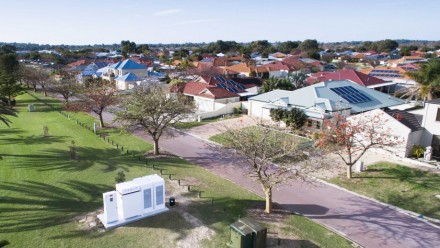Energy storage and recovery
Short-term energy storage is becoming increasingly important to smooth out peaks of high energy demand and low energy supply. This research cluster comprises of three main themes: material chemistry research, research into pumped hydro energy storage and fuel cell research.
Materials research
Materials chemistry research for energy conversion and storage is carried out at the Research School of Chemistry, where Professor Ray Withers and Professor Yun Liu have achieved a major research breakthrough in the development of a new material that can store large amounts of energy with very little energy loss.
The material has practical applications in renewable energy storage, electric cars and defence and space technologies. The new metal oxide dielectric material outperforms current capacitors in many aspects, storing large amounts of energy and working reliably from -190°C to 180°C, and is cheaper to manufacture than current components. The material could be particularly transformative for wind and solar power, which can cause problems when fed into the power grid at low demand times.
Additional research areas include functionality characterisation and device fabrication such as energy harvesting and storage devices. In new power electronic systems, there is major demand for high performance solid converters that enable a fast AC-DC conversion and a quick response to changes in voltage and waveform. These devices are likely to be critical in the practical application of renewable energy generation systems and smart grids and in electric vehicles.
Pumped hydro energy storage
A substantial new ANU energy research program is investigating off-river pumped hydro energy storage as a way of stabilising a 50-100% renewables contribution to the electricity system.
Whilst much attention has been on battery storage, Pumped Hydro Energy Storage (PHES) actually constitutes 99% of all existing energy storage around the world, primarily using conventional hydro-electric dams, because it is cheap compared with alternatives such as batteries.
Professor Andrew Blakers, Dr Matthew Stocks and their team are investigating the potential for energy storage via off-river PHES using relatively small (hectare-scale) reservoirs attached to large generators (50-500 Megawatts) which are much easier and cheaper to construct than large hydro-electric dams. This approach brings multiple benefits including reduced capital costs, reduced transmission costs, plentiful sites, avoidance of community conflict, and reduced environmental impacts. Their research has focussed on identifying and evaluating suitable sites around Australia.
The research is highly relevant for both policy makers and the electricity industry as decisions are made about increasing the penetration of renewables throughout the network. Nearly all new generation capacity in Australia is photovoltaics and wind energy, which are variable energy sources. PHES can help to stabilise the grid when PV and wind approach 50% or more of electricity generation. For example, South Australia is expected to reach this level within a few years.
More information can be found at http://re100.eng.anu.edu.au/.
Fuel cell research
Fuel cell research focuses on the development of new plasma processing techniques (similar to those used for microelectronics) to fabricate fuel cell components and on the electrical testing of fuel cell assemblies. Research areas include electrode development using platinum coated carbon nano-tubes and testing of integrated manufacturing system using commercially available membranes to separate electrons and protons. Fuel cell research is carried out in the Space Plasma, Power and Propulsion laboratory, Research School of Physics.
Energy nanomaterials
This research is focused on the liquid-state processing of electroceramics for energy applications and is carried out within the Research School of Electrical, Energy and Materials Engineering. This group creates novel nanostructured ceramics with high functionality in terms of high surface areas and quantum confinement effects. Over the years, the group has developed pure and doped metal oxide nanomaterials for use as thermoelectric materials, battery electrode materials, photocatalytic and water splitting materials.
Energy storage work has focused on the use of nanostructured vanadium oxides as cathode materials in rechargeable Li-ion batteries. Again, the unique processing conditions leads to unique nanostructures that can store large amounts of energy over a wide range of charging conditions. This work is supported by an extensive equipment portfolio including a glove box and associated battery processing stations, and a state-of-the-art electrochemical test facility, capable of myriad testing protocols that are standard for characterizing these systems such as impedance, charge-discharge and cyclic voltammetry.
Solar thermal energy storage
Energy storage technologies based on sensible, latent and chemical reaction heat are being developed by Professor Wojciech Lipinski’s team in the College of Engineering and Computer Science for low- and high-temperature solar energy applications. These include high-temperature metal-oxide, carbonate, ammonia and sodium based energy storage systems as well as clathrate hydrate systems for low-temperature energy storage.
Leaders
Researchers
- Dr Charles-Alexis Asselineau
- Senior Professor Amanda Barnard
- Honorary Professor Nick Birbilis
- Professor Andrew Blakers
- Professor Rod Boswell
- Dr Annie Colebatch
- Professor Joe Coventry
- Associate Professor Alexey Glushenkov
- Dr Siva Karuturi
- Emeritus Professor Elmars Krausz
- Professor Yun Liu
- Dr Bin Lu
- Dr Chathurika Mediwaththe
- Associate Professor Sally Moyle
- Associate Professor John (Jack) Pezzey
- Professor James Pittock
- Associate Professor John Pye
- Dr Igor Skryabin
- Professor Sean Smith
- Dr Matthew Stocks
- Dr Juan Felipe Torres Alvarez
- Professor Raymond Withers
- Dr Zongyou Yin
Students
2022
GIS-based solar and wind resource assessment and least-cost 100% renewable electricity modelling for Bolivia, Cheng Cheng, Natalia Pereira Gutierrez, Andrew Blakers and Matthew Stocks, Energy for Sustainable Development.
Recognizing the role of uncertainties in the transition to renewable hydrogen, Reza Fazeli, Fiona J Beck, and Matthew Stocks, International Journal of Hydrogen Energy.
Contributing to regional decarbonization: Australia's potential to supply zero-carbon commodities to the Asia-Pacific, Paul J Burke, Fiona J Beck, Emma Aisbett, Kenneth G H Baldwin, Matthew Stocks, John Pye, Mahesh Venkataraman, Janet Hunt, Xuemei Bai, Energy.
Indonesia's Vast Off-river Pumped Hydro Energy Storage Potential, David Firnando Silalahi, Andrew Blakers, Bin Lu, Cheng Cheng, Energies.
Pumped Storage Hydropower for Sustainable and Low-Carbon Electricity Grids in Pacific Rim Economies, Daniel Gilfillan and Jamie Pittock, Energies.
100% Renewable Energy in Japan, Cheng Cheng, Andrew Blakers, Matthew Stocks and Bin Lu, Energy Conversion and Management.
Fully electrified land transport in 100% renewable electricity networks dominated by variable generation Renewable Energy, Anna Nadolny, Cheng Cheng, Bin Lu, Andrew Blakers and Matthew Stocks, Renewable Energy.









